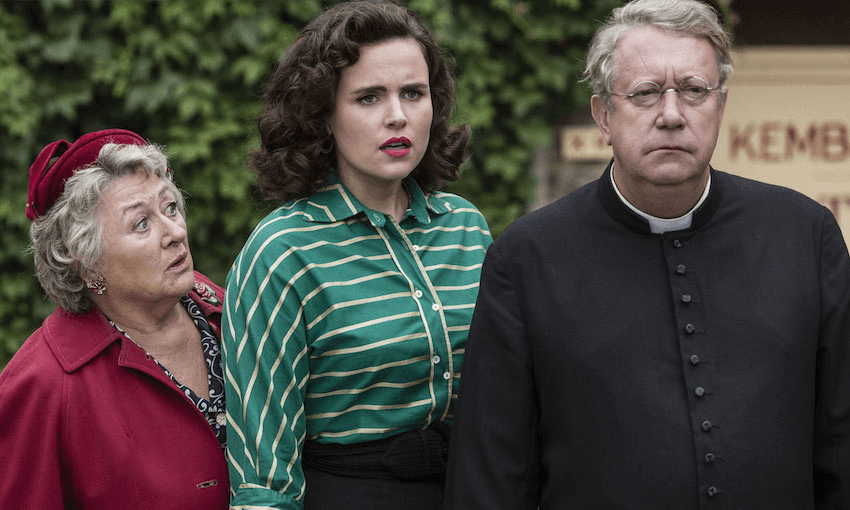Jam and Jerusalem. Bells and Smells. Tea and Cakes. Murder and Intrigue. Four of the classic double acts. And they all come together in the delightful investigation series Father Brown, five glorious seasons of which are available for your leisurely winter viewing on Lightbox.
As any Catholic lapsed or otherwise will tell you, the greatest Catholic thing to ever happen to television was Father Ted. Broad comedy, light on the politics, though still biting in its satire of parochial life, Father Ted was so good that I am certain I’m not the only Catholic who felt like Dermot Morgan’s early death was cause for a trip to confession. While Father Brown doesn’t style itself as a comedy, the jokes are plentiful especially for those of the Roman faith. Even if you’re not a Catholic, I’m sure you’ll have a raucous time.
Father Brown follows the time-honoured formula of the detective drama: discovery of the victim, police involvement, red herring, twist, a-ha moment, and final reveal. It’s cosy, it’s dependable. There are the character archetypes as well, all present and accounted for: the Local Aristocracy, the Bumbling Constabulary, the Neighbourhood Busy Body. And of course the man himself, Father Brown – a priest with a penchant for puzzles.
Mark Williams gloriously inhabits the central figure, kitted out in black cassock and wide brimmed hat, riding his bicycle around the fictional Cotswolds hamlet of Kembleford and sticking his nose into other peoples’ business.
Many audiences will know Mark Williams as Arthur Weasley in the Harry Potter films but he’s a terrific actor of boundless comic talent, as anyone who remembers him from late-90s BBC hit The Fast Show can attest. There’s more than enough Weasley in Father Brown to keep Potter fans happy, and Fast Show enthusiasts will be able to spot traces of Jesse (“this week I are be mostly eating”) popping out of his shed in The Fast Show:
Like other detective dramas of a similar vein – think Miss Marple or Midsomer Murders – there are plenty of cameos to keep an eye out for. Though instead of spotting many truly famous people in Father Brown, we’ll probably be looking back in a few years and discovering that the future Benedict Cumberbatch (of Mrs. Marple fame, and other things) was hidden amongst the prize-winning strawberry scones (in this case, Angus Imrie, son of Celia Imrie of Bext Exotic Marigold Hotel fame).
The best actor cameo (who also has the best possible name in the acting world) is Sylvestra Le Touzel, a woman who can deliver the words, “I shall be the second Penhallick with miraculous powers” with absolute conviction.
As an actor myself, shows like Father Brown seem to be the best fun you can have. The frocks are fabulous, the dialogue is absurd and wonderful, and you get to lark about in churches, stately homes, and, with alarming frequency, catacombs and vaults.
Back to the Catholicism for a moment. For a show about a priest you expect a few good Catholic tropes and gags, but Father Brown delivers in spades. Some highlights for me include an episode mostly set in a convent, appropriately titled ‘The Bride of Christ’. Every Catholic queer knows that there’s no greater lesbian icon than a nun.
Some of the lesbian nun pokemons that you can catch in this episode include Sadistic Taskmistress Nun, Mother Superior with a Sexy Secret, and Dumpy Bookworm Nun with a Wry Sense of Humour. This episode also contains a great bit of Catholic comedy where Dumpy Bookworm tells Father Brown that a particular nun with A Good Head For Maths goes by the nickname Sister Abacus.
Father Brown himself is an important figure in the lineage of fictional sleuths. GK Chesterton is said to have written Father Brown as a response to Sherlock Holmes. This may or may not be true, but I don’t think it’s necessarily important.
Sir Arthur Conan Doyle was clearly influenced by Edgar Allan Poe’s Dupin when he created Holmes; Lord Peter Wimsey is Holmesian as well, while Hornung’s Bunny and Raffles are diametrically opposed. In complete contrast, Father Brown’s chief stocks in trade as an amateur detective are his intuition, his paradoxical (for a man of the cloth) adherence to logic and reason, and a daring attitude to adventure that can only be the result of the firm conviction that God is on his side.
Forgive me Father for I have very much sinned in the 20+ years since my last confession. However, I do enjoy a nostalgic trip into an imaginary docile Catholicism, with plenty of talk of holy relics, and a benignly charming priest who throws shade at the Bishop (all bishops are absolute dickheads, it’s the rules of Catholic fiction). I do still have some fondness for aspects of the Catholic way of life, just not the laundries, the forced adoptions, the pernicious cover-ups of tremendous abuses of power, and the systematic destruction of the lives of hundred of thousands of children.
But if you enjoy murders as much as you enjoy garden centres, and you’re partial to a bit of proper English nonsense, I would suggest brewing a large pot of tea and getting out your knitting. Father Brown awaits!
